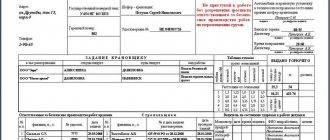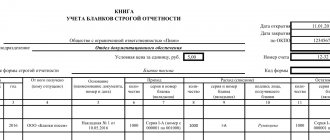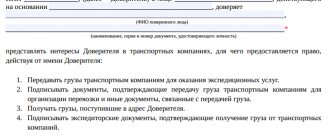business documents are widely used in the practical activities of people, enterprises, and organizations . The very process of creating a business document or recording information on various media according to established rules is documentation .
A set of documents, interconnected and interacting in a certain way, reflecting the activities of any enterprise forms a documentation system (a system of document support for the activities of an enterprise).
Definition of a document, its functions and classification
The definition of a document can be found in ISO standards and state standards of the Russian Federation (GOSTs).
- document, documented information - information recorded on a tangible medium with details that allow it to be identified [1];
- document (document, records) – identifiable information recorded on a tangible medium, created, received and stored by an organization or individual as evidence when confirming legal obligations or business activities [2].
A document can be created through writing, drawing, photography, film and sound recording, etc. Having recorded information, the document ensures its storage, accumulation, the ability to transfer to another person, repeated use, and return to information over time.
Any document can be considered from the point of view of the information carrier, the method of recording, the functions performed by the document, etc. The functions of a document represent the intended purpose of this document. The document performs two groups of functions: general and special.
General functions include : informational, social, communicative, cultural. Special functions : managerial, legal, historical source function (12-14% of all documents created in society).
There are no documents that perform only one strictly defined function. Any document is multifunctional. Therefore, it is possible to distinguish between documents only conditionally, for the convenience of their classification and analysis.
The whole variety of documents is divided, first of all, into official and personal documents . A document created by an organization or official and executed in the prescribed manner is called official .
Based on the stage of creation and execution, business documents are divided into the following types:
- The original (original) of an official document is the first or only copy of an official document.
- A draft document is a business document until it is signed by the relevant official.
- A copy of a document is a document that reproduces the information of another document and all or part of its external features. There are notarized, officially certified, simple certified, uncertified, diplomatic and other copies of documents.
- A duplicate of a document is a copy that has the force of the original, issued for documents that are issued in a single copy (certificate, diploma, birth certificate, etc.).
- An extract is a copy of part of a document, drawn up and certified in the prescribed manner.
Official documents, depending on the sphere of human activity they serve, are divided into managerial, scientific, technical (design), technological, production, etc. The office work services of an enterprise work with official documents, the vast majority of which are management documents.
In turn, the entire management documentation system of the enterprise is divided into :
- organizational and legal documents (charter, regulations on the organization, regulations, staffing table, job description, etc.);
- organizational and administrative documents (order, instruction, instruction, resolution);
- information and reference documents (business letters and notes, application, protocol, act, etc.).
There are other classifications of business documents.
Let's understand the concepts
The structure of a legal entity includes numerous representative offices, divisions and branches. All these are separate structural departments that are located outside the organization itself. But a branch, separate department or representative office does not become a new legal entity and is not endowed with property.
A structural branch is created so that a legal entity can carry out its activities in a new territorial location. The separate entity is endowed with the rights and powers to represent the interests of the parent organization, conduct business on its behalf, make payments, enter into agreements and contracts, and so on.
The company independently makes decisions on the creation and closure of separate divisions. The Federal Tax Service should be notified of the decision made in the prescribed manner.
IMPORTANT!
Useful: step-by-step instructions on how to properly close a separate division with all samples and forms.
Preparation of business documents
Drawing up business documents requires compliance with rules that ensure, first of all, their legal force . Registration is carried out using computer technology. Certain internal documents and personal documents (applications, powers of attorney, receipts, explanatory notes) may be written by hand.
the text of documents on A4 format forms with 1.5 - 2 line spacing, on A5 format or less - with one line spacing, in Times New Roman 14 font. The distance between individual details is from 1.5 (most business documents) to 3 line spacing (telegrams and telephone messages). If one attribute stretches over several lines, then its text is printed at one interval.
The pages of a business document must be numbered. If the first page of a document is a form, then it is counted, but not numbered. All subsequent pages are counted and numbered. In documents of limited access that have the appropriate stamp, all pages are subject to numbering.
Page numbers in business documents are written in Arabic numerals (without dots and dashes) in the middle of the top margin of the sheet of paper. It is allowed to execute documents with text printed on both sides of a sheet of paper. In this case, the pages are numbered on both the front and back sides.
The standard for the preparation of organizational and administrative documents related to the Unified System of Organizational and Administrative Documentation (USORD), included in OK 011-93 “All-Russian Classifier of Management Documentation” (OKUD) is presented in GOST R 6.30-2003 “Unified Documentation Systems. Unified system of organizational and administrative documentation. Documentation requirements."
Newsletter of the magazine "Personnel Department"
In the process of work of the personnel department of each institution, organization, enterprise, a large number of organizational and administrative documents (hereinafter referred to as ORD) are created both on the main issues of activity and on personnel (orders, instructions, certificates, acts, letters, etc.). According to the requirements of the Model Instructions for Office Work in ministries, state committees and other central government bodies, institutions, organizations and enterprises of the Republic of Belarus, approved by Order of the Committee on Archives and Office Work of the Republic of Belarus dated May 23, 1995 No. 13 (hereinafter referred to as the Model Instructions for Office Work) , these documents must be prepared on letterhead. Only certain documents (for example, internal documents of structural divisions) are allowed to be drawn up not on forms, but with the obligatory filling in of the details of the corresponding form products. Therefore, forms must be developed and used in every organization.
The form of an official document is a standard sheet of paper with permanent information of the document reproduced on it and space reserved for variable information.
The use of forms reduces the cost of document production, reduces the number of possible errors in its preparation and execution, and allows for the unification of document forms. In addition, using the form makes the document easier to perceive and improves its appearance. A correctly designed form is a kind of business card of the organization.
When developing, using and storing ORD forms, it is necessary to be guided by the requirements of the following regulatory legal acts:
§ Law of the Republic of Belarus of July 5, 2004 “On state symbols of the Republic of Belarus”;
§ Decree of the President of the Republic of Belarus dated June 28, 2000 No. 357 “On streamlining the production and use of document forms with the image of the State Emblem of the Republic of Belarus (as amended by Decree No. 482 dated October 4, 2004)”;
§ Resolution of the Council of Ministers of the Republic of Belarus dated July 31, 2000 No. 1172 “On approval of the Regulations on the procedure for the production and use of document forms with the image of the State Emblem of the Republic of Belarus and amendments to the Resolution of the Cabinet of Ministers of the Republic of Belarus dated August 7, 1995 No. 424”;
§ State Standard of the Republic of Belarus (STB) 6.38-2004 “Unified documentation systems of the Republic of Belarus. System of organizational and administrative documentation. Documentation requirements."
General requirements for forms are formulated in STB 6.38-2004. The standard establishes uniform rules for the preparation of operational documents, as well as the forms used in their preparation.
Document forms are produced on paper in A4 (210x297 mm) and A5 (148x210 mm) formats. The production and use of the latter is recommended in order to save paper when preparing small documents, such as cover letters.
The form must have margins: left - 30 mm, right - at least 8 mm, top and bottom - at least 20 mm. In this case, the application of fields or their limiting marks on the form (in the form of corners and lines) is not necessary.
STB 6.38-2004 establishes the following types of ORD forms:
§ letter form;
§ general form for other types of operational activities.
The letter form is used exclusively for preparing letters, regardless of their type (request letters, response letters, guarantee letters, cover letters, etc.).
Organizational administrative documents (orders, resolutions, instructions, etc.), as well as, in some cases, organizational documents (regulations, instructions, etc.) and reference and information documents (acts, protocols, certificates, etc.) are drawn up on general forms. .
Based on the general form, it is allowed to produce special forms for specific types of operational activities. For example, an organization can produce special forms for orders and protocols. According to the Model Instructions for Office Work, the production of special forms by type of document is considered appropriate if more than 200 such documents are created in an organization per year.
Business document forms
Business (administrative) documents are executed on blank sheets of paper or on letterhead. “ A form is a standard sheet of paper on which permanent information of a document is reproduced and space is allocated for variable information” [3].
Another definition: “ A document form is a set of details identifying the author of an official written document” [4].
GOST R 6.30-2003 establishes two standard formats for document forms - A4 (210 x 297 mm) and A5 (148 x 210 mm), the paper color is white or light colors. Each sheet of the document, whether on a form or without it, must have fields of at least :
- 10 mm - right;
- 20 mm - top;
- 20 mm - left;
- 20 mm - lower.
Forms in A4 and A5 formats are used primarily for the production of official letters, constituent and other administrative documents, contracts, certificates, notes, acts, etc.
A3 format forms (420 x 297 mm) are designed for reporting, accounting, statistical, planning and other documents containing tables with many columns.
A6 format forms (105 x 148 mm) are produced for managerial resolutions (instructions) or documents such as receipts, one-time passes, accounting forms, etc.
Samples of a general form, a corner and longitudinal form of a letter from an organization, a longitudinal form of a letter from an official, a form of a specific type of document of an organization are presented in GOST R 6.30-2003, Appendix B.
Clerk's cheat sheet
According to GOST R 7.0.8–2013. System of standards on information, librarianship and publishing. Record keeping and archiving. Terms and Definitions. a document form is a sheet of paper or electronic template with details identifying the author of an official document.
Forms of documents on paper and electronic templates of forms are produced on the basis of layouts of forms approved by the head of the organization.
Document forms should be prepared on white paper or light-colored paper.
Electronic templates of document forms must be protected from unauthorized changes.
Types of forms
In accordance with GOST R 7.0.97–2016 “System of standards for information, library and publishing. Organizational and administrative documentation. Requirements for document preparation."
The forms are as follows:
- General form. It is used to produce any type of document except a business letter.
The general document form includes the following details:
- coat of arms, emblem, trademark;
name of the organization that authored the document;
- place of compilation (publication) of the document.
- Letter form
The letter form includes the following details:
- coat of arms, emblem, trademark;
name of the organization that authored the document;
- reference information about the organization;
- document registration number;
- document date.
- Form of a specific type of document (order, instruction)
The form for a specific type of document includes the following details:
- coat of arms, emblem, trademark;
name of the organization that authored the document;
- document registration number;
- document date;
- name of the document type;
- place of compilation (publication) of the document.
Sample letter on a form Sample order on a form
GOST R 7.0.97–2016 added 2 types of forms: a structural unit form and an official form .
However, the use of forms with such details is not necessary. The organization itself has the right to decide which forms it will use.
To prepare documents electronically, electronic form templates , which allow you to create legally valid documents in electronic form. They reproduce all details in electronic form (except for the coat of arms). Can be used many times.
Document forms are made based on the longitudinal or angular arrangement of the details. The location of the details on the form does not affect the legal validity of the document or its legal status.
On a longitudinal form, the details are placed along the top margin and centered.
Longitudinal forms in practice are used primarily for preparing orders, instructions, and protocols.
The most convenient and economical is the corner form . In this case, the right side of the top of the sheet is used to place the “Addressee” details of the “document approval stamp” and writing resolutions.
Forms of acts and letters can be angular.
Rules for using forms:
- For the production of organizational and administrative documents, two formats of forms are established in accordance with GOST 9327–60: A4 and A5, with field sizes of at least:
left - 20 mm; right - 10 mm; top - 20 mm; lower - 20 mm.
The organization has the right to decide for itself what margin sizes it is advisable to set for various types of documents, but not less than the sizes that are established.
- Draft letters, orders and instructions prepared jointly with other executive authorities of constituent entities of the Russian Federation or organizations are printed on standard sheets of paper (A4 format) without a form.
- In order to account for the number of forms in an organization, typographically, forms must be produced that have as a requisite the State Emblem of the Russian Federation or the emblem of a constituent entity of the Russian Federation. Copies of printed forms are not permitted.
- Documents constituting internal correspondence (official memo) are drawn up on standard sheets of A4 paper without the use of forms.
- The use and recording of forms is carried out by the office or the employee responsible for office work.
- The document form is approved and put into effect by order of the organization.
Samples of organizational document forms are developed by the records management service. Also, the initiators of the production of document forms can be structural divisions of the organization or officials who have the right to sign the form. In this case, they, in the manner prescribed by the organization’s office management instructions, can send a memo to the office management service for the production of a form for a structural unit or official.
Copy or download:
Sample form of a business letter Sample form of a document “For official use” Sample order on a form Sample order on a form
It was necessary to legislate the activities of government structures and streamline documentation processes.
On October 30, 1917, the Council of People's Commissars issues a decree on the procedure for approving and publishing laws. To establish the procedure for processing administrative documents, a resolution of the Council of People's Commissars of March 2, 1918 was adopted on the form of forms of state institutions, which listed the mandatory details of the document form. During the formation of the Soviet state apparatus, much attention was paid to simplifying and rationalizing office work. So, on December 8, 1918, the Council of Workers' and Peasants' Defense issued a resolution on the accurate and rapid execution of orders of the central government and the elimination of clerical red tape. [p.23] All modern word processors support working with templates. Templates include styles. A template is, in general, a plan for the text, graphics of a document, and a set of ways to format its individual parts. The concept of using a template for preparing a certain type of document best suits the goals of modern office work, standardizing documents to automate work with them and improve the culture of managerial work. The modern design of the form and a complete set of information about the company improve the reader’s perception of the document and have a beneficial effect on business contacts with partners. Once correctly compiled and beautifully designed, a template of a certain type of document allows you to use it as many times as necessary in the process of documenting the activities of the enterprise. [p.416] Particularly highlighted are the issues of documenting management activities, the concept of a document, types and varieties of documents, requirements for the preparation of document forms, registration of all document details, as well as the rules for the preparation of organizational, administrative and information and reference documents included in the system of organizational and administrative documentation . The issues of organizing work with documents are covered, including the organization of document flow, technology for registering documents, monitoring the timing of their execution, and information and reference work. The rules for storing documents in office work and preparing them for filing in the archive are considered. [p.4]
Maintaining office work in the prescribed manner, keeping records of incoming correspondence and strict reporting document forms. [p.326]
The article Stationery, printing, telegraph, postal and telephone expenses includes expenses for the purchase of office, writing supplies and materials (pens, pencils, ink, writing and copying paper, erasers, etc.), production and purchase of accounting books, books on office work, forms and statements, binding and binding of documents, printing costs, payment for various postal items (parcels, parcels, money orders, office telegrams, etc.), costs for the purchase of reference and periodical literature (directories, bulletins, etc. .), payment for telephone calls. [p.203]
The office work service organizes advanced training for employees in the preparation and execution of documents, studying GOSTs and changes to them, it is entrusted with the preparation of job descriptions for office work personnel, the development and implementation of unified forms of document forms, the preparation of instructions for office work, nomenclatures of cases, various reminders necessary when working with documents, reference books, etc. The office work service ensures the uniformity of office work in all structural parts of the institution and in the organizations and enterprises subordinate to it. [p.128]
Control over the production, use and storage of stamp forms is entrusted to the division of the organization responsible for the organization's office work. Persons personally responsible for recording, using and storing forms are appointed by the administrative document of the head of the organization. [p.50]
At the beginning of the 19th century. collegiums were replaced by ministries, collegiality in leadership was replaced by unity of command. An executive (ministerial) office work has developed. Forms for official documents appeared, archives were created in each department to store files, and the introduction of mechanization of office work began. [p.6]
Represents correspondence received by the enterprise, copies of administrative documents, forms, forms according to the classifier, methodological assistance developed at the enterprise in matters of record keeping. [p.391]
Changes in the management system and office work also led to changes in the form of the document. In the clerical work of ministries, forms of institutions appear with the angular arrangement of details. Forms were printed or written by hand. The details of the form include the name of the institution, the names of structural units (department, division, desk), date and registration number of the document. A separate place is occupied by the title to the text of the document, which is located directly below the details of the form (the same as in modern documents). A link to the received document also appears (prototype of modern details Link to the date and number of the received document), which is not yet unified and may look different Reply to No.... or From such and such, etc. [p.19]
The organization in the external environment is presented as a single whole, a legal entity, therefore all its documents, regardless of the division and the official who compiled them, must be uniform in terms of the form and content of permanent details. As we will see later, regulatory documents on office work often allow for some variety in the execution of individual details, giving the organization the opportunity to choose the option that suits it most. For example, the detail Reference data about the organization, which is among the permanent details for external documentation, according to the standard must necessarily include only the postal address of the organization, and the remaining elements (telephone numbers, faxes, telexes, e-mail, bank accounts, INN, BIC) - according to at the discretion of the organization. Therefore, management must decide what the organization’s form with permanent details will look like, and communicate this decision to all persons preparing documents for its mandatory implementation. The form template can be executed on a computer and entered into the database of all computers used to prepare documents. It is appropriate to provide an image of the organization’s letterhead in the Office Management Instructions. [p.23]
At the beginning of the 19th century, collegiums were replaced by ministries, and collegiality in leadership was replaced by unity of command. Enforcement proceedings have developed. Forms for official documents appeared, and the introduction of mechanization of office work began. [p.6]
The general procedure and rules for drawing up instructions are defined in paragraph 4.2 of the Standard Instructions for Office Work. As a rule, instructions for a type of activity are applied as an independent legal act, signed by the head of the relevant structural unit responsible for developing the document. Instructions for the type of activity of an enterprise (organization, institution) are approved upon the proposal of the head of the relevant enterprise by the federal, local or departmental executive body. The approval is made in the form of an approval stamp or by issuing an administrative document on their approval. The instructions are printed on the general letterhead of the enterprise. [p.89]
Customs is a fairly flexible structure that quickly responds to external changes. Thus, already in June 2003, before the new GOST R6.30-2003 came into force, the North-West Customs Administration (NWCU) developed and sent out to subordinate customs authorities methodological recommendations for the preparation of letters and draft orders. The Novgorod customs office produced new document forms with details in accordance with the new GOST, and trained those responsible for paperwork on document preparation. [p.42]
In the course of carrying out the documentation operations assigned to him, the secretary accumulates information about the state of documentation support both for the organization as a whole and for its structural divisions, including the quality of document execution, the timing of their execution, the formation and storage of files, the use of technical means (for example, about conducting teletype negotiations), using official forms, etc. The regulations on the organization of the work of management and its interaction with the secretary provide for the regular (at least once a month) transmission of generalized information on the above issues to management for consideration. You can also check the status of office work in the structure [p.157]
Preparation of certificates is an integral part of the work on preparing at the enterprise (organization) draft regulations and organizational and administrative documents. The general procedure for preparing certificates for draft documents submitted for signature and approval is carried out in accordance with the Standard Instructions for Office Work. Thus, according to paragraph 3.3.9 of the specified Instructions, a certificate for a draft act (document) is drawn up on standard forms or standard sheets of A4 paper and has the following details [p.129]









